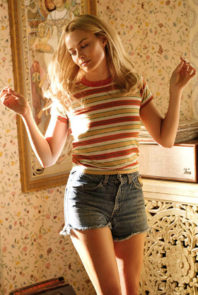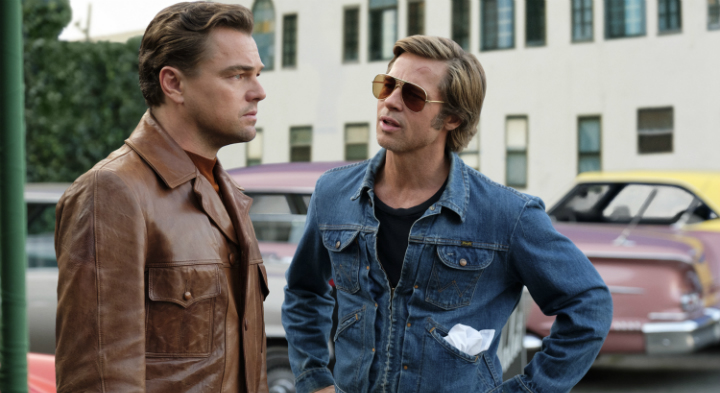
Quentin Tarantino’s latest film, Once Upon a Time … in Hollywood tells the story of Rick Dalton (Leonardo DiCaprio), a one-time TV star who lost his lustre. Rick made a name for himself on a western series called Bounty Law, but his career stalled after he made the jump to film. Now he’s stuck guest-starring as the heavy on other actors’ shows. He’s no more than a punching bag; there to make the younger, hotter actors look like stars.
Speaking of punching bags, Rick is often accompanied by his loyal stuntman/driver/friend Cliff Booth (Brad Pitt). And the film makes it clear; there is no Rick without Cliff. Rick does all the smiling and preening in the spotlight, but Cliff puts in the grunt work – and risks his neck – to make him look like a million bucks.
It’s 1969, and American culture is undergoing a tectonic shift. The hippy movement (which represents new Hollywood) is encroaching upon Rick, and he can see the writing on the wall. The industry has no more use for old-school guys like him. When the movie begins, a Hollywood big-shot (Al Pacino) approaches Rick about flying to Italy to shoot spaghetti westerns. It’s a blow to the actor’s ego, but he must consider it since he’s running out of options.
Rick is one of Tarantino’s finest creations, fully brought to life by a first-class DiCaprio performance. He gets that his moment has passed, and it’s crushing his soul. You can read the character as a stand-in for Tarantino, who has been Hollywood’s cool kid since exploding onto the scene almost three decades ago.
The rebellious young director who revolutionized the early ‘90s indie scene isn’t young, exuberant and full of fresh ideas anymore. He’s now a middle-aged man with old-school tastes. And he creates talk-heavy films at a time when Marvel movies dominate the multiplexes. Tarantino is at an age where directors’ talent begins to fade, and this film expresses his dread of losing his edge.
There is one more layer of text weaved into the movie. Dalton exists at the point when New Hollywood stamped out classic Hollywood. It’s when Bonnie and Clyde and Easy Rider changed all the rules of what movies could be. And filmmakers like Francis Ford Coppola, George Lucas, and Martin Scorsese started succeeding guys like David Lean, Billy Wilder and Alfred Hitchcock.
This theme emerges in the presence of what Rick calls “Dirty Hippies,” who exist at the edges of the story. These Charles Manson acolytes slowly close in on Rick and Cliff as the plot unfolds. And as anyone with a loose understanding of the Manson murders knows, they’re presence poses a physical and existential threat to the characters.
DiCaprio delivers some of his finest work in this picture. He plays Rick as a tangled web of fear, insecurity, and resentment that shows up in stutters, tics, and his hollow bluster. Rick spent his life chasing fame, not greatness. And now, in his career’s twilight, he has little to show for it – aside from a home filled with posters of himself. Casting DiCaprio, an ageing sex-symbol on the wrong side of 40, injects another layer of meta text into the story.
I’ve heard people make the case that Pitt is a world-class character actor cursed with leading man good looks. And seeing him here as Rick’s sidekick strengthens that argument. He comes off as so cool and charming that all you want to do is spend time with him in his rich world. It’s difficult envisioning anyone else but DiCaprio and Pitt in these two exceptional roles. Tarantino uses Pitt’s affability as a trap, slowly reeling you in before revealing who Cliff really is. It’s a masterful ploy and tough to explain without getting too spoilery.
Margot Robbie’s Sharon Tate is the third straw that stirs the narrative drink. Tate’s role is less prominent but no less significant. Sharon, Rick, and Cliff depict the three phases of Hollywood stardom; the star on the rise, the star in decline, and the schmuck whose just happy to be on set. Robbie’s Tate shines every moment she’s on-screen. We see her dance, laugh, and look on in awe as Sharon sits in a theatre watching her own performance on screen. She is the sunrise to Rick’s sunset in Hollywood’s circle of life. And they highlight two cogs in a vicious machine that chews actors up and spits them out.
Once Upon a Time … in Hollywood isn’t the type of Tarantino movie people are anticipating. First of all, it is not a plot-driven film. It reminds me of a Richard Linklater-style hangout movie. It’s all about spending time with these deeply considered characters and soaking up the vibe in their lavish world. What they represent is as important as what they say and do. The movie does take its time getting us to where it’s going. And at 161-minutes, there is plenty of time for the story to meander and digress, but that’s not a bad thing.
The threat of the Manson murders hangs over the picture like a guillotine blade. That knowledge acts as the story’s driving force and casts a dark shadow over everything that happens. One scene, where Cliff visits the Hippies’ flophouse plays out with the menace of a horror flick. If you get a kick out of the tone and atmosphere, the nearly three-hour runtime zips by.
You won’t hear Tarantino’s signature dialogue slipping off the characters’ tongues. The film isn’t littered with Sonny Chiba, Top Gun, and Silver Surfer references, which makes sense tonally. How can characters reminisce about a golden era when they live inside Tarantino’s idealized version of that period? Why discuss obscure Bruce Lee stories when you can simply put Bruce Lee in the movie? This tamer streamlined Tarantino is no less compelling, and I still got a kick out of listening to his characters speak. But don’t expect to hear his whiz-bang dialogue.
Despite all the talk of waning greatness, Tarantino hasn’t lost a step. He’s a master filmmaker who crafted yet another spellbinding film. He meticulously recreates 1969 Los Angeles with a stylish hodgepodge of vintage cars, throwback movie posters, and neon signs. The costumes, production design, and classic soundtrack create a vision of LA that you could get lost in forever. The movie looks stunning.
Once Upon a Time … in Hollywood tones down Quentin’s Tarantino-ness to tell a wistful tale of a golden era’s final days. The filmmaker reminisces over classic Hollywood while detailing the tides of change that swept it away. Tarantino recreates the past, not as a real place, but as a romanticized ideal, to lay out a tale that is emotionally vivid but factually murky. The result is a mesmerizing movie full of captivating characters, sublime production design, and Oscar-worthy performances.
- Release Date: 7/26/2019



